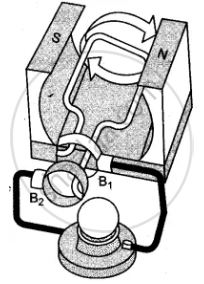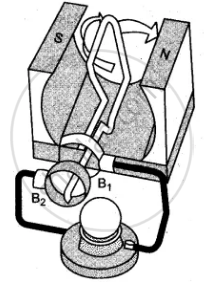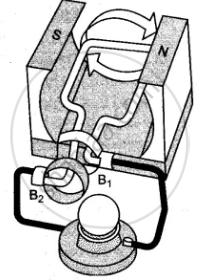Advertisements
Advertisements
प्रश्न
Explain the underlying principle and working of an electric generator by drawing a labelled diagram. What is the function of brushes?
उत्तर
Principle: An electric generator works on the principle of electromagnetic induction phenomenon. According to it, whenever a coil is rotated between the poles of a magnet, an induced current is set up in the coil, whose direction is given by Fleming’s right hand rule.

Working: Let in the beginning, as shown in Fig. brushes B1 and B2are kept pressed separately on rings R1 and R2 respectively. Let the axle attached to the rings is rotated such that arm AB of the coil moves up and arm CD moves down in the magnetic field. Due to rotation of arms AB and CD induced currents are set up in them. As per Fleming’s right hand rule induced currents in these arms are along the directions AB and CD. Thus an induced current flows along ABCD and current in the external circuit flows from B2 to B1.
After half a rotation, arm AB starts moving down and the arm CD upward. Therefore, directions of induced currents in these arms change. Thus net induced current now becomes in the direction DCBA. In the external circuit now current flows from B1 to B2. Thus after every half rotation current changes its direction and an alternating current is obtained from the generator.
Function of Brushes: Brushes are kept pressed on the two slip tings separately. Outer ends of the brushes are connected to the galvanometer (or the external load). Thus brushes help in transferring current from the coil ABCD to the external circuit.
APPEARS IN
संबंधित प्रश्न
A coil of insulated copper wire is connected to a galvanometer. What will happen if a bar magnet is pushed into the coil?
What change should be made in an a.c. generator so that it may become a d.c. generator?
What is the function of brushes in an electric generator?
Complete the following sentence:
A generator with commutator produces ............... current.
State two ways in the which the current alternating current and direct current?
Suggest two ways in an a.c. generator to produce a higher e.m.f.
What energy conversion does take place in a generator when it is in use?
State one advantage of using a.c. over d.c.
Draw a neat labeled diagram of an A.C. generator
The given figures 1 to 3 show the working of a simple A.C. generator. Study the diagrams and answers of the following questions.



(i) State and explain the principle underlying the working of a simple generator.
(ii) Where is the loop of wire placed?
(iii) What happens when the loop is rotated?
(iv) Indicate the direction of the current flow through the wire for the first half of the turn (in first figure). Name and state the rule used in finding the direction of the current.
(v) Indicate the direction of the current for the case shown in second figure.
(vi) Indicate the direction of current in the outer circuit (i.e., electric bulb) in first and third figure.
(vii) What type of current is shown in the above diagrams? Explain.
